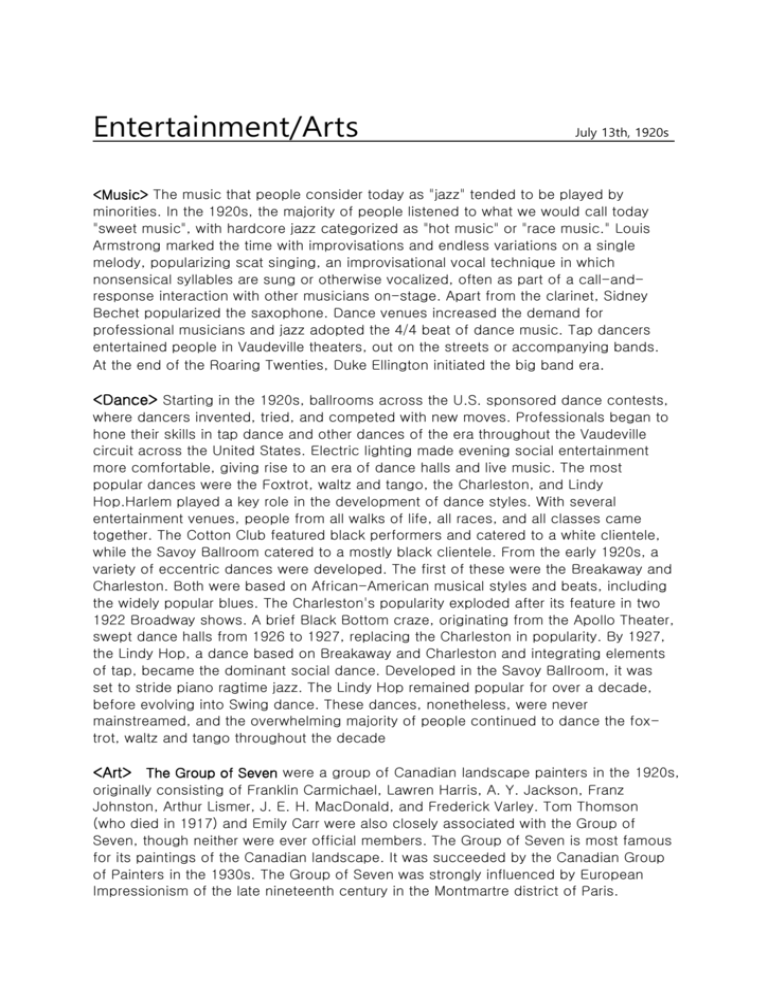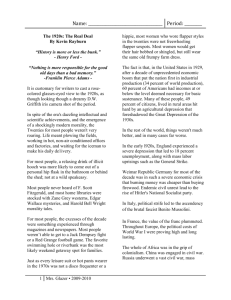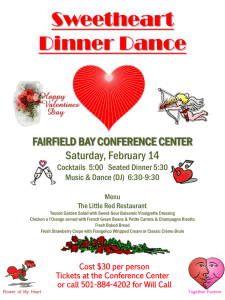Newspaper rough - HorizonsSecondarySchool
advertisement

Entertainment/Arts July 13th, 1920s <Music> The music that people consider today as "jazz" tended to be played by minorities. In the 1920s, the majority of people listened to what we would call today "sweet music", with hardcore jazz categorized as "hot music" or "race music." Louis Armstrong marked the time with improvisations and endless variations on a single melody, popularizing scat singing, an improvisational vocal technique in which nonsensical syllables are sung or otherwise vocalized, often as part of a call-andresponse interaction with other musicians on-stage. Apart from the clarinet, Sidney Bechet popularized the saxophone. Dance venues increased the demand for professional musicians and jazz adopted the 4/4 beat of dance music. Tap dancers entertained people in Vaudeville theaters, out on the streets or accompanying bands. At the end of the Roaring Twenties, Duke Ellington initiated the big band era. <Dance> Starting in the 1920s, ballrooms across the U.S. sponsored dance contests, where dancers invented, tried, and competed with new moves. Professionals began to hone their skills in tap dance and other dances of the era throughout the Vaudeville circuit across the United States. Electric lighting made evening social entertainment more comfortable, giving rise to an era of dance halls and live music. The most popular dances were the Foxtrot, waltz and tango, the Charleston, and Lindy Hop.Harlem played a key role in the development of dance styles. With several entertainment venues, people from all walks of life, all races, and all classes came together. The Cotton Club featured black performers and catered to a white clientele, while the Savoy Ballroom catered to a mostly black clientele. From the early 1920s, a variety of eccentric dances were developed. The first of these were the Breakaway and Charleston. Both were based on African-American musical styles and beats, including the widely popular blues. The Charleston's popularity exploded after its feature in two 1922 Broadway shows. A brief Black Bottom craze, originating from the Apollo Theater, swept dance halls from 1926 to 1927, replacing the Charleston in popularity. By 1927, the Lindy Hop, a dance based on Breakaway and Charleston and integrating elements of tap, became the dominant social dance. Developed in the Savoy Ballroom, it was set to stride piano ragtime jazz. The Lindy Hop remained popular for over a decade, before evolving into Swing dance. These dances, nonetheless, were never mainstreamed, and the overwhelming majority of people continued to dance the foxtrot, waltz and tango throughout the decade <Art> The Group of Seven were a group of Canadian landscape painters in the 1920s, originally consisting of Franklin Carmichael, Lawren Harris, A. Y. Jackson, Franz Johnston, Arthur Lismer, J. E. H. MacDonald, and Frederick Varley. Tom Thomson (who died in 1917) and Emily Carr were also closely associated with the Group of Seven, though neither were ever official members. The Group of Seven is most famous for its paintings of the Canadian landscape. It was succeeded by the Canadian Group of Painters in the 1930s. The Group of Seven was strongly influenced by European Impressionism of the late nineteenth century in the Montmartre district of Paris. Tom Thomson, J. E. H. MacDonald, Arthur Lismer, Frederick Varley, Frank Johnston and Franklin Carmichael met as employees of the design firm Grip Ltd. in Toronto. In 1913, they were joined by A. Y. (Alexander Young) Jackson and Lawren Harris. They often met at the Arts and Letters Club of Toronto to discuss their opinions and share their art. This group received monetary support from Harris (heir to the Massey-Harris farm machinery fortune) and Dr. James MacCallum. Harris and MacCallum jointly built the Studio Building in the Rosedale ravine to serve as a meeting and working place for the new Canadian art movement. Emily Carr (December 13, 1871 – March 2, 1945) was a Canadian artist and writer heavily inspired by the indigenous peoples of the Pacific Northwest Coast. One of the first painters in Canada to adopt a post-impressionist painting style, Carr did not receive widespread recognition for her work until later in her life. As she matured, the subject matter of her painting shifted from aboriginal themes to landscapes, and, in particular, forest scenes. As a writer, Carr was one of the earliest chroniclers of life in British Columbia. The Canadian Encyclopedia describes her as a "Canadian icon". Fashion/Fads July 13th, 1920s The Flapper History: The costume history image in our minds of a woman of the 'Roaring Twenties' is actually likely to be the image of a flapper. Flappers did not truly emerge until 1926. Flapper fashion embraced all things and styles modern. A fashionable flapper had short sleek hair, a shorter than average shapeless shift dress, a chest as flat as a board, wore make up and applied it in public, smoked with a long cigarette holder, exposed her limbs and epitomized the spirit of a reckless rebel who danced the nights away in the Jazz Age. Attainable Fashion for All: High fashion until the twenties had been for the richer women of society. But because construction of the flapper's dress was less complicated than earlier fashions, women were much more successful at home dressmaking a flapper dress which was a straight shift. It was easier to produce up to date plain flapper fashions quickly using flapper fashion Butterick dress patterns. Recorded fashion history images after the twenties do reflect what ordinary women really wore rather than just the clothing of the rich. The flapper fashion style flourished amid the middle classes negating differences between themselves and the truly rich, but continuing to highlight some differences with the really poor. The really rich still continued to wear beautifully embellished silk garments for evening, but the masses reveled in their new found sophistication of very fashionable flapper clothes. The Short Skirt Misconception of the Twenties: New students of costume history often mistakenly assume that all dresses day and evening were short in every year of the twenties and that flappers were the only fashion style of the twenties. Dress and coat lengths were actually calf length and quite long for most of the decade. Shortness is a popular misconception reinforced by the availability of moving film of the Charleston dance which shows very visible knees and legs on the dancing flappers. *Skirts only revealed the knee briefly between 1926 and 1928, and this was the only period when evening dresses were short in line with day dress lengths. Flappers: Immortalized in movies and magazine covers, young women’s fashion of the 1920s was both a trend and a social statement, a breaking-off from the rigid Victorian way of life. These young, rebellious, middle-class women, labeled ‘flappers’ by older generations, did away with the corset and donned slinky knee-length dresses, which exposed their legs and arms. The hairstyle of the decade was a chin-length bob, of which there were several popular variations. Cosmetics, which until the 1920’s were not typically accepted in American society because of its association with prostitutions, became, for the first time, extremely popular. Advertisement section July 31st, 1929s







